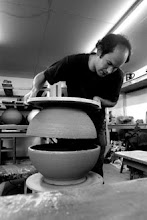A pot inspired me. Amazed me, but I had got exited about objects and forms before. For some reason this simple form wouldn’t leave me alone or more to the point I can’t let it go. A spherical jar with an open rim and narrow foot ring is all it is; yet I have been making them for over three years. That may not sound a long time but it is virtually the only form I have concerned myself with since I saw my first Moon Jar in the V&A in 2004. Moon Jars are a Korean form from the Choson dynasty (1392-1910) originally made from plain white porcelain. At the time they represented the epitome of austere Confucian taste. The one I saw Bernard Leach had brought back from Seoul. Leach and his contemporaries in Japan admired it for its lack of self- consciousness, and the beauty of its slight imperfections. I was also struck by these qualities, its serenity and simplicity.
I see that I am unusual among potters, as I have no range, I make one form and that is all I do. Yet to my eye (and I am sure anyone who takes a moment to look) I never make the same form. This is neither deliberate nor accidental and that I find really interesting. I am in control of my skills, I know my form, how to make it, how to repeat it, yet I never do? A single pot inspired me and I have never tried to replicate it. I have always tried to capture its inspiring qualities and to capture its form. I think it is the form that enthrals me, makes me want to make another and another. Due to the making process and perhaps my immature skills I can make the shape proficiently but the subtleties of the form are beyond my complete control. I relish and nurture that lack of control, as I am certain I do not want to produce identical pots. But I do want the form to be perfect. I want perfection yet the form I am striving for is far from perfect. Paradoxical though it is, I think this is what fascinates me what drives me to continue.
I think that this is a part of a maker’s skilful journey, to start out with an intension and to strive to perfect that in a true form. For a long time I wanted to make them a perfect sphere. Pushing the belly further and further out to create a round jar. Eventually I realised I was going to far. They were losing their elegance. In my latest batch I have brought them right back in and the feel is very different, still the same components but a new form and a new presence. I ask myself if its boring making the same shape over and over but I have not once felt board nor have I lost interest in the seemingly infinite variety of a spherical jar.


 My second attempt at this project after the previous Jar was taken from the top of Clegyr Boia. A new more remote location this time on top of Carn Treliwyd.
My second attempt at this project after the previous Jar was taken from the top of Clegyr Boia. A new more remote location this time on top of Carn Treliwyd. 





